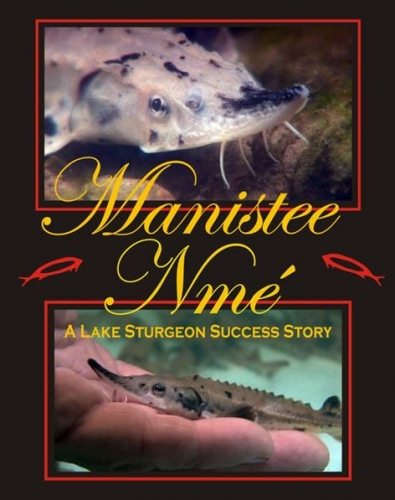Manistee River sturgeon success story
A new documentary highlights the efforts of the Little River Band of Ottawa Indians and their pioneering techniques to restore the lake sturgeon in the Great Lakes.
Kathy Johnson saw a dinosaur in the Big Manistee River. She was ready; the camera was rolling. After 100 million years, Manistee’s lake sturgeon – a fish virtually unchanged from its Jurassic cousin – finally got its close-up.
This amazing high-definition footage comes alive in “Manistee Nme’: A Lake
Sturgeon Success Story,” a documentary about the Little River Band of Ottawa Indians
(LRBOI) Lake Sturgeon Rehabilitation Program produced by Gregory A.D. The 30-minute film hits the screen
on Thursday, April 12 with a free, public
showing at 7 p.m. at Hemlock Crossing Nature 
Hemlock Crossing is part of the Ottawa County Parks system, and is located just west of U.S. 31 in West Olive. The nature center also features interpretive displays that include a lake sturgeon replica and information on sturgeon populations around Lake Michigan.
No reservations are necessary and all are encouraged to attend. Don’t forget the kids, says LRBOI Fisheries biologist Marty Holtgren, who will introduce the film and field questions from the audience.
“What is cooler than seeing a six-foot Manistee sturgeon?” he asks, adding that the entertaining movie format will capture youth and adult attention alike and expose the audience to science and culture “in an interesting manner.”
The film – the first of its kind starring Manistee’s sturgeon – highlights a program, also the first of its kind. The Little River Band of Ottawa Indians Lake Sturgeon Rehabilitation Program is in its 10th year, after the Tribe took action to stop the dwindling lake sturgeon population from disappearing completely.
The fish face many challenges, as they don’t sexually mature until they are 20 years old and only spawn every four years. Combined with habitat loss, pollution, historic over-fishing and a tendency to get hung up on boat props and in nets due to their size, the lake sturgeon is now listed as threatened in Michigan waters.
The Tribe’s approach to the problem is multi-faceted. After first studying the small population cruising between the Big Manistee River and Lake Michigan, biologists started the first Lake Michigan sturgeon streamside larvae rearing facility. This trailer protects the tiny larvae from predators, yet keeps them in the home waters of the Manistee River to imprint the sturgeon with unique markers that will call the sturgeon back when they’re ready to spawn.
The fish are tagged, and once they reach a healthy size, the fingerlings are released back into the river. The public participates in the releases as a community, and the Tribe celebrates the sturgeon’s cultural importance.
“It is unacceptable to let species (any native) go away without even trying and to understand what we would lose,” Holtgren said.
Adapted from a press release written by Allison Batdorff



 Print
Print Email
Email

